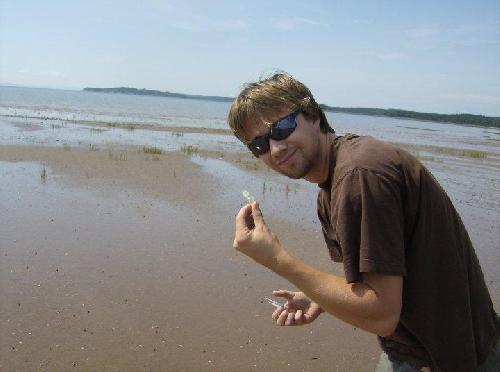The researchers behind a forthcoming study in The Auk: Ornithological Advances have shown that Semipalmated Sandpipers on their annual stopover in Canada's Bay of Fundy eat a far broader diet than anyone suspected--and they did it by analyzing poop.
Analysis of stomach contents had led researchers to believe that Semipalmated Sandpipers in the Bay of Fundy rely on an amphipod species called Corophium volutator as their major food source. However, the new study of feces by Travis Gerwing, Myriam Barbeau, Diana Hamilton, Jason Addison, and Jin-Hong Kim of the University of New Brunswick shows that the sandpipers' diet knits together several adjacent food webs--freshwater insects that wash down onto the beach in streams and eggs of ocean-going fish deposited on the shore by tides get eaten alongside organisms that live in the beach's intertidal zone.
This broader diet may increase their exposure to pesticides and other toxins, in addition to making the birds more resilient to changes in their habitat, such as those due to climate change. "Current Semipalmated Sandpiper conservation efforts in the Bay of Fundy focus on beach and intertidal habitats, neglecting terrestrial, pelagic, and freshwater systems that may not only supply nutrients, but harmful chemicals or pesticides as well," according to Gerwing. "Future studies need to explore this possibility, attempting to determine if bioaccumulation of harmful toxins from multiple ecosystems in the Semipalmated Sandpipers are having any negative impacts upon this species."
 Researcher Travis Gerwing collected Semipalmated Sandpiper feces in the Bay of Fundy to study the birds' diet. Credit: A. Gerwing
Researcher Travis Gerwing collected Semipalmated Sandpiper feces in the Bay of Fundy to study the birds' diet. Credit: A. Gerwing
Gerwing and his colleagues obtained their data using a technique called "molecular scatology"--analyzing the DNA contained in the sandpipers' feces. "The best part of molecular scatology is that it can be entirely non-invasive. I never touched a single Semipalmated Sandpiper," says Gerwing. "I would get to relax on a beach with my wife (a very hard life) and watch these birds forage through our binoculars. Once they naturally moved on, we would run down to where they were foraging and pick up their feces. My poor wife had to watch as I spent the next few minutes crawling over rocks and mud, picking up bird poop with a pair of sterile tweezers."
"Molecular detection of trophic interactions through next-generation sequencing is a technique increasingly used in ecological studies to address various questions regarding predation, herbivory and parasitism. By using this approach, Gerwing et al. showed that Semipalmated Sandpipers utilized diverse foods and foraging habitats during fall stopover in the Bay of Fundy, Canada, which opposes the traditional view about the prevalence of amphipods, Corophium volutator, in the diets of birds at this location," according to Ivana Novcic of Kean University, an expert on the foraging ecology of shorebirds at stopover sites. "This study provides better insights into the diet of Semipalmated Sandpipers, which may have important implications regarding the study of group foraging, competition, niche partitioning, food webs and other ecological phenomena."
source: Central Ornithology Publication Office